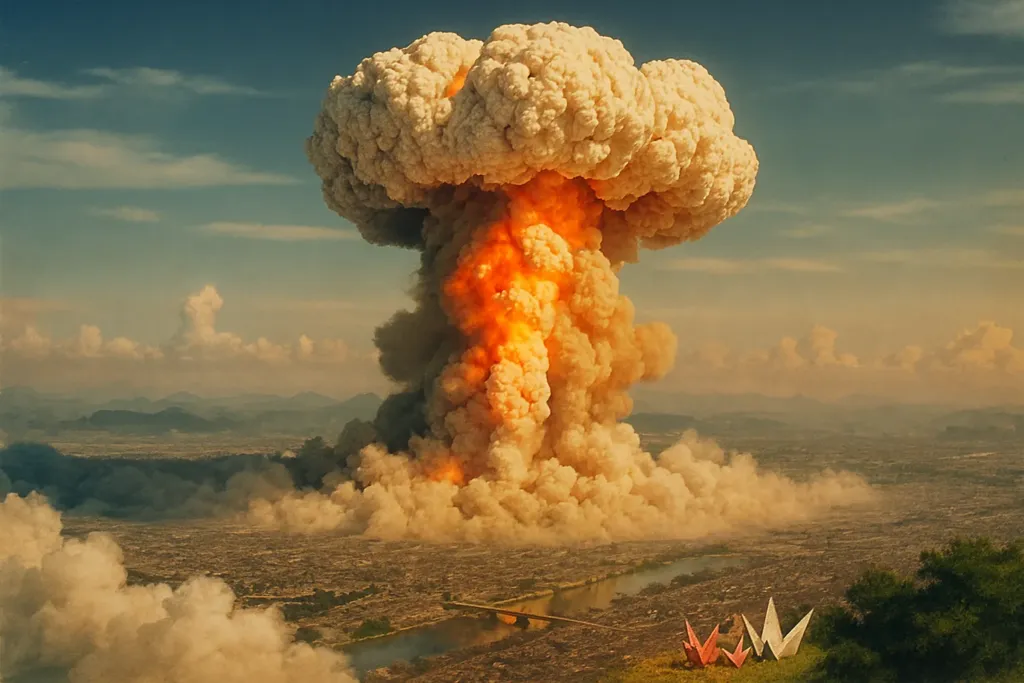Historical context
On August 6, 1945, at 8:15 a.m., the B‑29 Enola Gay dropped the uranium bomb “Little Boy” over Hiroshima. Detonating about 600 meters above the city with an estimated yield of roughly 15 kilotons, it devastated the urban core. The Aioi Bridge served as the aiming point; the hypocenter was near Shima Hospital. Tens of thousands died instantly; by the end of 1945, total deaths reached roughly 140,000–150,000, including those who succumbed to burns and radiation. The city was razed but rebuilt, placing remembrance at the heart of its identity.
What happened on August 6
Thermal radiation caused immediate burns while the blast shattered buildings across several kilometers. “Shadow” imprints of people and objects on stone and concrete became haunting markers of the moment. Radiation led to acute and long-term effects; survivors-hibakusha-faced health and social challenges for decades. Their testimonies now anchor exhibits and programs, inviting visitors to listen rather than merely read.
Memory, ethics, and visiting culture
Hiroshima’s Peace Park is a space for silence and reflection, not dark tourism. Keep a respectful tone: modest dress, calm demeanor, and no playful selfies at memorials. Some museum exhibits restrict photography; turn off flash and avoid disturbing others. Each August 6, the city holds a remembrance ceremony with a moment of silence and floating lanterns—profound yet gentle, asking for presence and care.
What to see
Musts include the Genbaku Dome (the preserved skeletal frame of the former Industrial Promotion Hall), the Peace Memorial Museum, the park’s Bell of Peace, and the Children’s Monument to Sadako and the thousand cranes. Nearby, Hiroshima Castle (reconstructed) and Shukkeien Garden offer restorative walks. For a day trip, head to Miyajima: Itsukushima Shrine with its “floating” torii, tame deer along the waterfront, and views of the Seto Inland Sea. It balances remembrance with nature’s horizon.
Getting there and getting around
From Tokyo, the Nozomi shinkansen takes about 4 hours; services with transfers take longer. From Osaka or Kyoto, it’s roughly 1.5–2 hours. Airport buses connect Hiroshima Airport to the center in about 45–60 minutes. In town, Hiroden trams link major sights, including the main station and Peace Park. Walking is easy downtown—leave time to drift between memorials, rivers, and tree-lined paths.
Best time and practical tips
Late spring and early autumn bring comfortable weather and clear skies. August is hot and crowded, especially on the 6th; if attending the ceremony, arrive early, bring water, and wear light, modest clothes. Visit the museum on weekday mornings to avoid peak times. Respect personal space—many visitors process strong emotions. Refuel with Hiroshima-style okonomiyaki, local oysters, and citrus desserts from the region—small comforts after a demanding visit.
A day itinerary
Begin at the Peace Memorial Museum (2–3 hours), continue through the park to the Genbaku Dome. Lunch by the riverside, then Shukkeien or the castle grounds. If you have energy, train to Miyajimaguchi and ferry to Miyajima for sunset. Return to the quiet streets downtown—Hiroshima teaches you to see the light without forgetting the shadow.
Why it matters
A trip to Hiroshima isn’t a checkbox; it’s a personal conversation with history. The city shows how memory can become a bridge to empathy and responsibility. You’ll leave with new questions-and that’s the journey’s true value.
- Alaska
- Glorious sea — sacred Baikal
- Moab
- Rhino Poaching Crisis Threatens Biodiversity and National Identity
- The September 11 Terrorist Attack: How the Tragedy Changed Tourism
- Macau
- Island
- Bolivia
- Turtle facts
- The World’s Most Dangerous Countries for Tourism in 2025
- Nanai
- Istanbulkart Scams: What Tourists Should Watch Out For
- Great lakes
- Tonga
- Apple in tourism: how the brand became a travel attraction
- Where tourists are kidnapped for ransom
- Shakira — Waka Waka (This Time for Africa)
- Derbent (Dagestan, Russia)
- Somalia: A Country of Risk and Contrasts — Is It Worth Going?
- Tsunami in Sri Lanka: the tragedy that changed tourism











